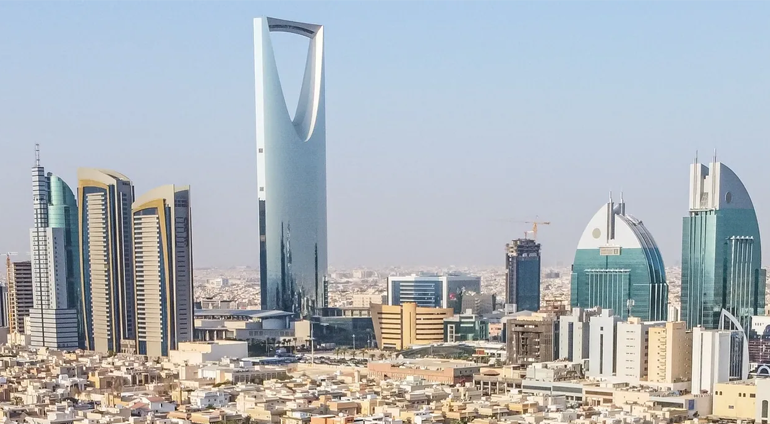Saudi Arabia’s insurance market, the second largest in the Gulf region by gross written premium after the UAE, offers a vibrant and competitive environment. Growth in recent years has been attributed to economic development creating new insurable assets, and new lines of mandatory coverage, according to Oxford Business Group.
Insurance market in Saudi Arabia continued grow in 2023 with gross written premiums at SR53.3 bn ($14.2 bn) and rising 26.8%. The Saudi central bank (SAMA) reported that the local insurers recorded a 8.4% turnover increase in 2022. The latter went from 338.8 bn SAR (10.3 bn) in 2021 to 42 bn SAR (11.2 bn) in 2022.
Brokers captured 38.4% of the market, and agents claimed 5.2%. Commissions paid by insurance companies amounted to SR2.1 bn ($559.9 mn).

With Vision 2030 providing the overarching framework and direction of travel, the insurance sector’s evolutionary process for the remainder of the decade is clear: insurers are to consolidate, in the process, amassing deeper capital reserves to lower systemic risks across the financial sector.
They are also expected to embrace digitalisation opportunities evidenced in global trends across the industry. Both retail and commercial consumers can expect to find more options for interacting with insurers and intermediaries, in particular via smartphone applications. Digitalisation will also overhaul back-office functions and procedures, enhancing the processes for activities like claims, compliance and accounting.
Insurance market structure
Kingdom had 29 insurers, takaful (Islamic insurance) providers and reinsurers, as well as 179 brokers and other service providers. In addition to the pandemic’s effect on the economy, in recent years insurance operators have encountered volatility in oil prices, intense competition, and constrained fiscal and business spending (see How Digital Technology Adopting Can Help GCC Insurance Companies).
Long-term direction is detailed in the country’s Vision 2030 development plan and targets a growing and maturing sector through consolidation, digitalisation and overall capacity building.
Like insurers worldwide who responded to the global Covid-19 pandemic by updating their operations and leveraging insurance technology (insurtech), many Saudi insurance companies have entered a period of rapid digitalisation and modernisation.

The increasing population and diversification of the nation’s economy are among the key factors driving the Saudi Arabia insurance market. Resulting from the growing industrialization and increasing job opportunities, expatriates from all around the globe are migrating to the country, catalyzing the growth of the insurance sector.
Insurance penetration fell in 2022 and 2023 to 1.3%, down from 1.5% in 2021, according to the most recent “Saudi Insurance Market Report” published by the Saudi Central Bank (SAMA). That figure compares with a global average of 7.3%.
Saudi Arabia’s rate has risen somewhat inconsistently, and new insurance business has not kept pace with the Kingdom’s expanding GDP. The compound annual growth rate (CAGR) for insurance penetration is relatively low, at -2.7%.
The low growth can be partly explained by low levels of demand and awareness among Saudi consumers, although the authorities are taking steps to augment demand-side factors and enhance efficiencies on the supply side.
Conditions are similar in insurance markets across the region, and authorities have long encouraged mergers and acquisitions (M&A) to rebalance the volume of providers with the demand for their services. Several mergers took place in 2022, establishing a trend likely to continue over the coming years.
These developments are partly an outcome of the Financial Sector Development Programme, which was created in 2017 to help achieve the goals outlined in Vision 2030. The aim is to foster diversity in the sector, stimulate savings, develop more financial tools to support economic activity and diversify sources of income. The aims are intended to enhance the performance of the financial services sector, while simultaneously lower systemic risks (see Global Risk Management Survey).
Regulatory moves such as boosting capital requirements and making more types of insurance mandatory should go a long way towards achieving these goals. Additional measures include adopting international standards, such as implementing more rigorous accounting practices to stimulate consolidation and boost sector resiliency.
Lines of Insurance Business

The Saudi insurance sector is segmented into three main lines of business: health, general and P&C insurance. Health insurance has grown rapidly since its introduction, accounting for 66% of total GWP in 2022, 59.7% of total GWP in 2021.
P&C insurance, the smallest market segment, accounted for around 4.1% of total GWP. Although the least common type of insurance, the jump to 4.1% breaks out of a recent range of around 3%.
The customer profile for P&C insurance is dominated by large enterprises, which accounted for 65.6% of GWP. Retail insurance accounted for 12.9% of the total, with micro-, small- and medium-sized enterprises accounting for 4%, 6.3% and 11.2%, respectively. This trend of large-scale customers comprising the most significant share will likely continue in the future, given the giga-projects being developed under Vision 2030, which will create new and valuable assets to insure (see about Global Commercial P&C Insurance Sector).
However, as awareness of the benefits of insurance remains limited across the Kingdom, insurers can also work to grow the market share – particularly in retail lines of business. To address this, insurance companies and brokers across the Kingdom are working to raise awareness about the importance of coverage and the risks associated with being uninsured.
Motor insurance is the dominant segment within the general category, accounting for 19.4% of GWP. The category is dominated by intense competition and, therefore, features slim profit margins.
It is also notable for its high retention rate, with insurers retaining 94.2% of premium, rather than passing on a greater share of risk to reinsurers (see about Property & Motor Insurance Market in Asia-Pacific).
Growth in GWP is expected to come from enhanced enforcement of existing rules that mandate motor coverage. Motorists have slipped through the cracks in coverage and gone uninsured; however, greater enforcement mechanisms are expected to change that (see about Global Motor Insurance Market).
Most lines of business reported growth, with motor and medical segments topping the list with the biggest contributions of 78% and 66% to GWPs and net underwriting income.
The Saudi insurance market is dominated by the health activity with 30 bn SAR (7.8 bn) of written premiums, which represents nearly 60% of the total premium income.
The Saudi Arabia health insurance market reached a value of $ 6.5 bn in 2021. Looking forward, expects the market to reach $ 9.4 bn by 2027, exhibiting a CAGR of 6.4% during 2022-2027.
Saudi insurance market by shares per class of business
| Class of business | Shares |
| Disease | 59.74% |
| Automobile | 19.42% |
| Property damage and fire | 5.43% |
| Accidents and civil liability | 3.78% |
| Energy | 3.08% |
| Engineering | 2.38% |
| Transport martime | 1.66% |
| Aviation | 0.45% |
| Total non-life | 95.94% |
| Savings & pensions | 4.06% |
| Grand total | 100% |
Absher, an online platform and smartphone app developed by the Ministry of Interior, offers Saudi citizens access to government services such as job applications, pilgrimage permits, renewing driving licences and passports, and checking the validity of motor insurance. This digitalisation process should reduce the number of uninsured vehicles, according to analysis from Fitch, with GlobalData forecasting a CAGR of 3.4% in the domestic motor insurance segment between 2020 and 2025.

The volatility in the insurance market comparative results, which were visible until the first half of 2022, have settled now in terms of the loss ratios and the net profit after Zakat and tax.
The industry-wide loss ratios and net profit after zakat and tax stand at 82% and SR710 mn in 2023
The total assets and total equity of the insurance industry stood at SR79 bn and SR19 bn, showing an increase of 20% and 4.8%, respectively, compared to December 31, 2021.
This represented an annualised return on equity of 4% as of 2022, and annualised return on assets of 0.96% as of 2022.
Insurer’s Consolidation
There is widespread agreement on the need for consolidation, with a large number of insurers and only a handful of them controlling significant market share. In 2022 the eight-largest insurers underwrote 77.2% of GWP, leaving the remaining 22.8% to 21 smaller competitors.
This presents a risk identified in the country’s Vision 2030 economic blueprint, as a fragmented market has greater potential for instability.
Vision 2030 envisions a smaller roster of sizeable insurers with the capital required to withstand challenges and handle insuring large projects. In 2021 SAMA signalled a rise in paid-up capital requirements, to be implemented over three years, from a minimum of SR100m ($26.7m) to SR500m ($133.3m).
Insurers could sell more shares in rights issues; however, this is expected to become harder to manage, especially at the scale needed to meet the new standards.

Hence, mergers are expected, and some have already begun. In 2020 the first agreement was announced, with general insurance specialist Walaa acquiring Metlife in a stock deal in which Metlife shareholders received 1.52 Walaa shares for each of their Metlife shares. The acquisition allowed Walaa to move into the P&S side of the insurance sector, where it previously had no presence. Walaa, which had SR646m ($172.2m) in paid-up capital as of 2021, has expressed an interest in acquiring smaller rivals.
In another stock-based deal, in December 2020 Gulf Union Cooperative Insurance acquired Al Ahlia Insurance. In December of 2021 the new company, Gulf Union Al Ahlia Cooperative Insurance, announced it was in merger discussions with Al Sagr Insurance. According to Gulf Union, the new company would feature benefits such as sufficient capital to compete in the market, in addition to improving service delivery, boosting financial capabilities, increasing market share and cutting costs. Meanwhile, in 2022 Aljazira Takaful Taawuni acquired Solidarity Saudi Takaful in a similar deal, boosting its paid-up capital from SR350m ($93.3m) to SR470.7m ($125.5m).
SAMA has been clear in its expectation that consolidation should continue in the coming years.
Another reason is the regulator’s progress in adopting the International Financial Reporting Standards (IFRS) 17, an accounting process for insurers issues (see analysis). IFRS standards are a global norm allowing foreign investors a degree of familiarity and certainty about financial reporting in a particular market.
Insurance Digitalisation
Alongside consolidation, the priority area for development at the corporate level is technology, with digitalisation seen as the answer to multiple challenges. The pace of digitalisation in the insurance sector worldwide sped up with the onset of the global Covid-19 pandemic. Insurers and intermediaries were compelled to find more ways to reach customers with digital options and to use those tools for more of their functions.
SAMA has formally encouraged insurers to digitalise their operations and services, from sales to claims settlements.
It also introduced new rules for the insurtech segment to protect customers and enable companies to innovate, while remaining compliant with rules and regulations. Examples include rules for engaging practitioners, licensing and ensuring the accuracy of customer data.
In an example of prioritising the digitalisation process, in 2018 Bupa Arabia for Cooperative Insurance announced the creation of a digital transformation department, one of the first of its kind, to push such reforms through. In 2020 it introduced a telehealth platform to connect its members to major health care providers through services like online appointment booking, and online health consultations between patients and medical practitioners.
Another notable example of streamlining service delivery is the partnership between Najm for Insurance Services and the government’s General Directorate of Traffic. This partnership offers a remote review service for minor traffic accidents in which there are no injuries or need for first responders at the scene. Participants can submit pictures of the damage through a Najm app, allowing both parties to continue their journeys, avoid blocking traffic and initiate a claims process. The first phase of the system was launched in Riyadh in April 2022.
………………………..



 by
by 




